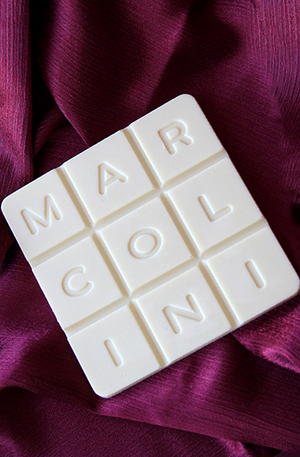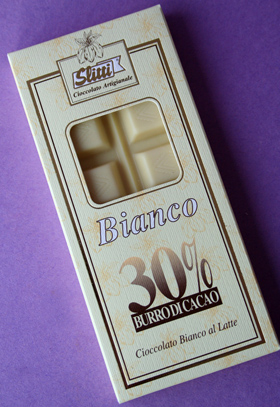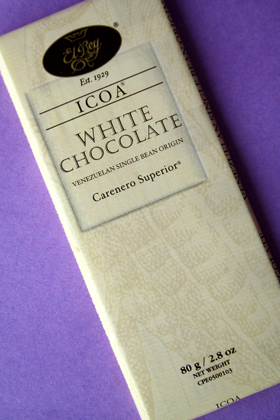 |

| |

Pierre Marcolini’s white chocolate bar wins the beauty competition. Real white chocolate is ivory, never snow white. All photography by Claire Freierman. |
| WHAT IT IS: Twelve of the world’s finest white chocolate bars. |
| WHY IT’S DIFFERENT: More cocoa butter in the recipe, top-quality cocoa butter and a more restrained hand with sugar give these bars aroma and flavor complexities unmatched in lesser white chocolate. |
| WHY WE LOVE IT: For the same reason we like all great chocolate. Nothing else tastes this good! |
| WHERE TO BUY IT: Chocosphere.com and MarcoliniChocolatier.com (for the Pierre Marcolini bar only). |
|
|
 |

The World’s Best White
Chocolate
Page 3: Percent Cacao & Cocoa Butter
This is Page 3 of a five-page review. Click on the black links below to visit other pages.
INDEX OF REVIEW
MORE TO DISCOVER
|
Percent Signs (%) On White Chocolate Bars
Now, what about those “% cacao” signs that you’ll see on some bars of white chocolate? When you see them on a milk or dark chocolate bar, they tell you what percent of the bar is cocoa solids. But what about a white chocolate bar, that has no cocoa solids to begin with?
The number is telling you the percentage of cocoa butter. Remember that the government-required minimum is 20%; thus, the most average white chocolate bar will have 20% cocoa butter. When you see a number like 28%, 30% or 33% on a bar, you know that the manufacturer is proudly proclaiming that it’s good stuff. The higher the percentage of cocoa butter, the richer and creamier the bar and the more nuanced the flavor. Real white chocolate is rich and creamy and tastes like a member of the chocolate family. Fake white chocolate (confectionary coating) doesn’t.
White chocolate hasn’t garnered the same appreciation as dark chocolate, mainly because, without cocoa solids, it lacks the same breadth of flavor that makes cacao varietals and the percent cacao content in a bar such a vast and exciting world to explore. |

Some gourmet white chocolate bars proudly proclaim their high percentage of cocoa butter (the legal mimimum is 20%, and we’ve seen brands with up to 33%). |
What White Chocolate Lovers Should Know About Cocoa Butter
Since most of the quality of the white chocolate is the cocoa butter in it, the more you know about cocoa butter, the more you’ll understand white chocolate.
Cocoa butter is the natural vegetable fat present in the cacao bean. Beans are approximately 52% cocoa butter by weight (the amount varies by the variety of cacao bean); the rest is cocoa solids. After the cacao beans are roasted and finely ground, they are hot from grinding, and are liquid due to their natural high fat content. The cocoa butter is squeezed from the hot chocolate liquor by high pressure (a hydraulic press). It is pressed through fine screens that permit the run-off of the cocoa butter. It solidifies into a yellowish-white fat, solid at room temperature.
Color
The first rule of thumb is that good white chocolate is never white! Its color should reflect the ivory and off-white shades of cocoa butter. If you see white chocolate that is literally white, you can bet that it isn’t real white chocolate. It’s confectionary coating and should be labeled as such, although it often isn’t, especially when sold by local artisans. (We recently bought some toffee from a small specialty toffee shop, that was “dipped in white chocolate.” The minute it arrived, we saw from the snow-white color that it was confectionary coating. The toffee was good, the coating, not.)
Provenance Of The Cocoa Butter
The geography of the cacao beans from which the cocoa butter is derived may influence the texture of white chocolate. As different geographical regions produce beans with different flavors and aromas, they produce cocoa butters of differing hardness levels:
- South America: softest cocoa butter
- Central America and Africa: intermediate hardness
- Asia and Oceania: hardest cocoa butter
What difference does the hardness make? The soft South American cocoa butters are better suited for the cosmetic industry, whereas the hard Asian cocoa butters are probably more beneficial for couverture, the large blocks of chocolate from which candy, fine baked goods and ice cream are made. But these disparities are now in danger of facing uniformity, as recent studies suggest that hardness levels among geographically different cocoa butters are becoming more alike.
Deodorized Cocoa Butter
Before cocoa liquor is molded into blocks of couverture, it must first receive a little extra cocoa butter in the conch. This is done to increase the fluidity and the mouthfeel of the finished chocolate. But cocoa butter—after it has been pressed and separated from the beans—often has a strong and undesirable taste, which can negatively affect the flavor of the finished chocolate. Thus, manufacturers will deodorize, or remove, the natural aroma and flavor of the cocoa butter to produce a flavorless and neutral product. By deodorizing the cocoa butter, a manufacturer can combine cocoa butter pressed from different types of beans, and sell the amalgamated cocoa butter. Since, as noted above, the cacao bean is at least 52% cocoa butter, manufacturers of cocoa powder will have a lot of cocoa butter to sell!

El Rey Icoa is the only chocolate bar made with undeodorized cocoa butter, which gives it a true chocolate flavor. |
Deodorized cocoa butter is perfect for milk chocolate and dark chocolate (most of what any manufacturer produces). But it makes white chocolate, which has no chocolate liquor to provide flavor, taste more bland. This is why many experts feel that El Rey’s white chocolate, Icoa, is the finest in the world. Its cocoa butter has not been deodorized and retains its natural flavor. Icoa is the only white chocolate in the world made with undeodorized cocoa butter.
The economical benefits derived from deodorizing cocoa butter are sensible, but the practice can lead to relatively similar-flavored white chocolate bars. Some disparities will exist in bars according to brand, however, but for the most part these differences can be too subtle in a casual tasting, which is how white chocolate is most often consumed.
(We’re not saying you’ll like El Rey the best, we’re just explaining the science.) Icoa, by the way, is the protector goddess of native Venezuelans who travel by rivers and lakes. Her relationship to white chocolate? She is said to have a “white” soul. |
Now that you know as much as most people will ever know about white chocolate, let’s taste our favorites.
Continue To Page 4: The Best White Chocolate Bars
Go To The Article Index Above
Do you have friends who would enjoy THE NIBBLE?
Click here to send them an invitation to sign up for their own copy. |
© Copyright 2004-2025 Lifestyle Direct, Inc. All rights
reserved. All information contained herein is subject to change at any time
without notice. All details must be directly confirmed with manufacturers, service
establishments and other third parties. This material may not
be reproduced, distributed, transmitted, cached, or otherwise used, except with
the prior written permission of Lifestyle Direct, Inc.
|
 |


|
 |










